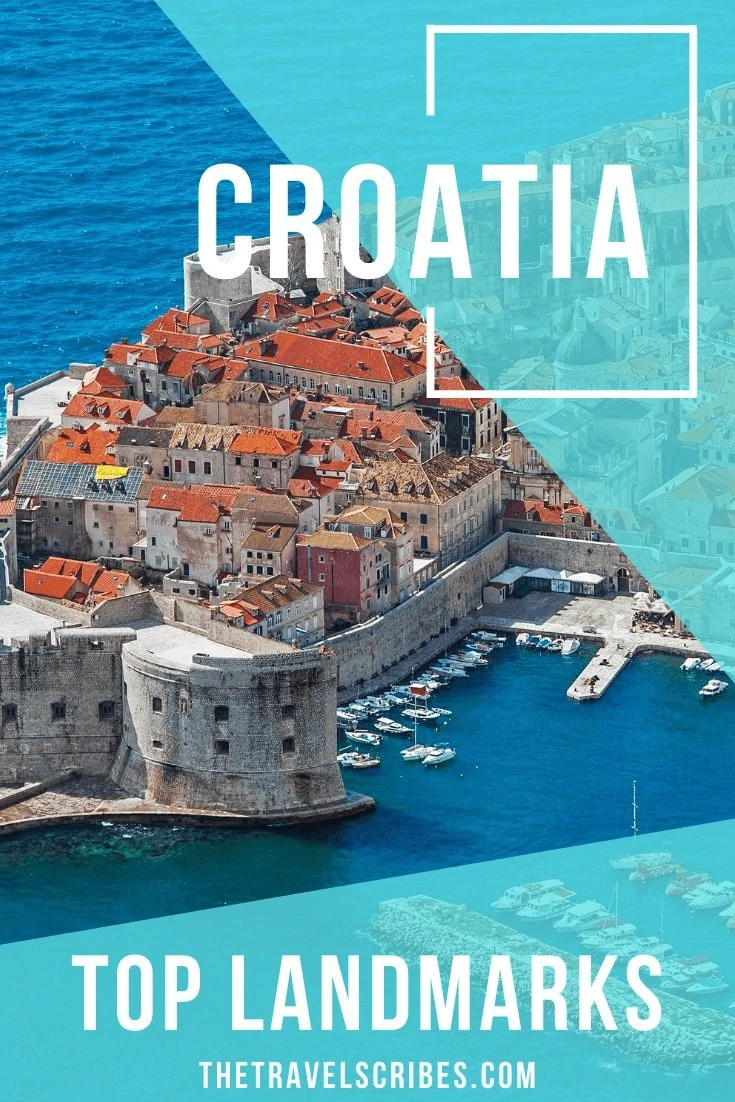Croatia is one of our favourite countries in the Mediterranean, and even though over the last few years has gathered a little more prominence, it still isn’t in the same league as the likes of Spain or Greece when it comes to seaside destination of choice. It’s time to change that and get travellers to explore the many charming corners of this gem in the Adriatic, as they visit some of the must-visit landmarks in Croatia.
And although we have been very lucky to spend a few days in Split, travel from Zagreb to Zadar, island hopped around the Adriatic and ended up in Dubrovnik, we haven’t even nearly covered off half of the most amazing attractions to see. So, we had to ask some of the best travel writers in the business to add in their leading landmarks in Croatia. Read on to find out which momentous monuments, bold buildings and striking sights made it onto the list…
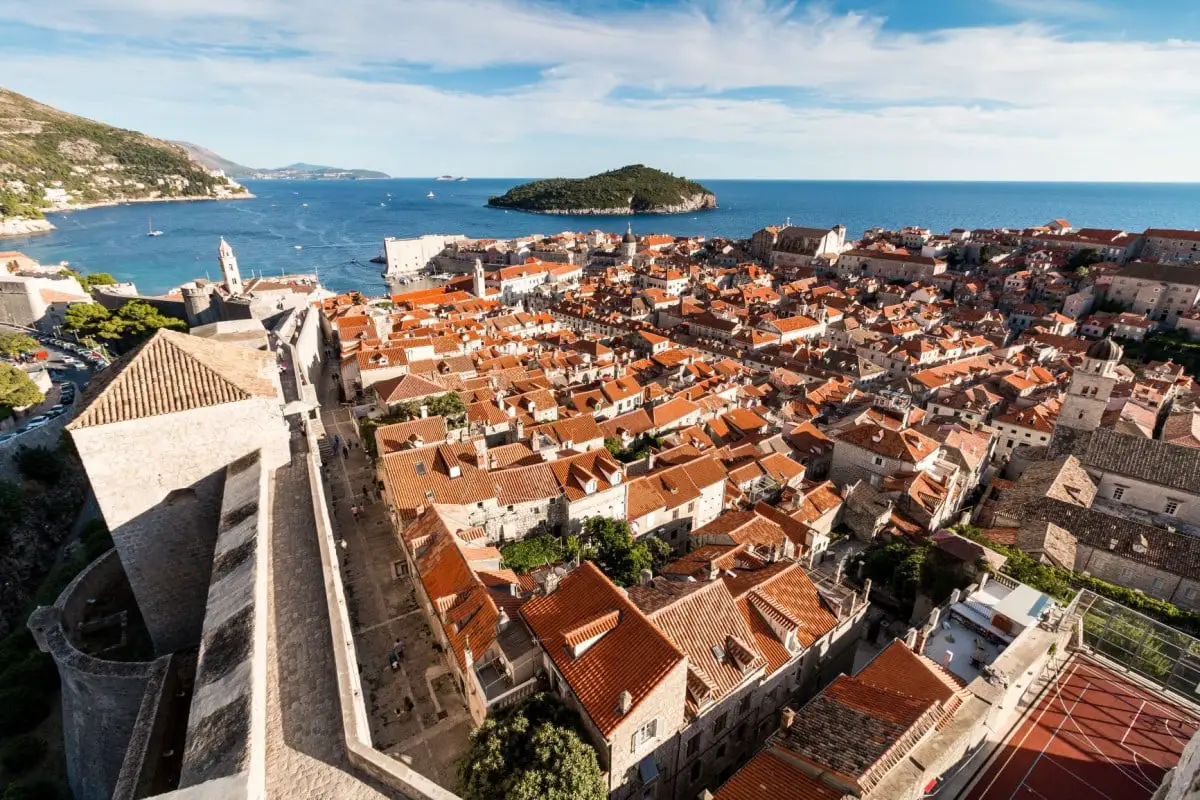
Read next: What are the must-see landmarks in England?
Skip ahead
Our top 10 landmarks in Croatia
It’s always difficult to create a list of unforgettable places but, under duress, here’s what would top the table of the best Croatia landmarks:
- Plitvice Lakes National Park
- Diocletian’s Palace, Split
- Dubrovnik City Walls
- Krka National Park
- Zlatni Rat, Brac
- Korcula Old Town
- Spanish Fortress, Hvar
- Pula Arena
- St Mark’s Church, Zagreb
- Salona Ruins
Plitvice Lakes National Park
Explored by Karen from Big Adventures for Little Feet
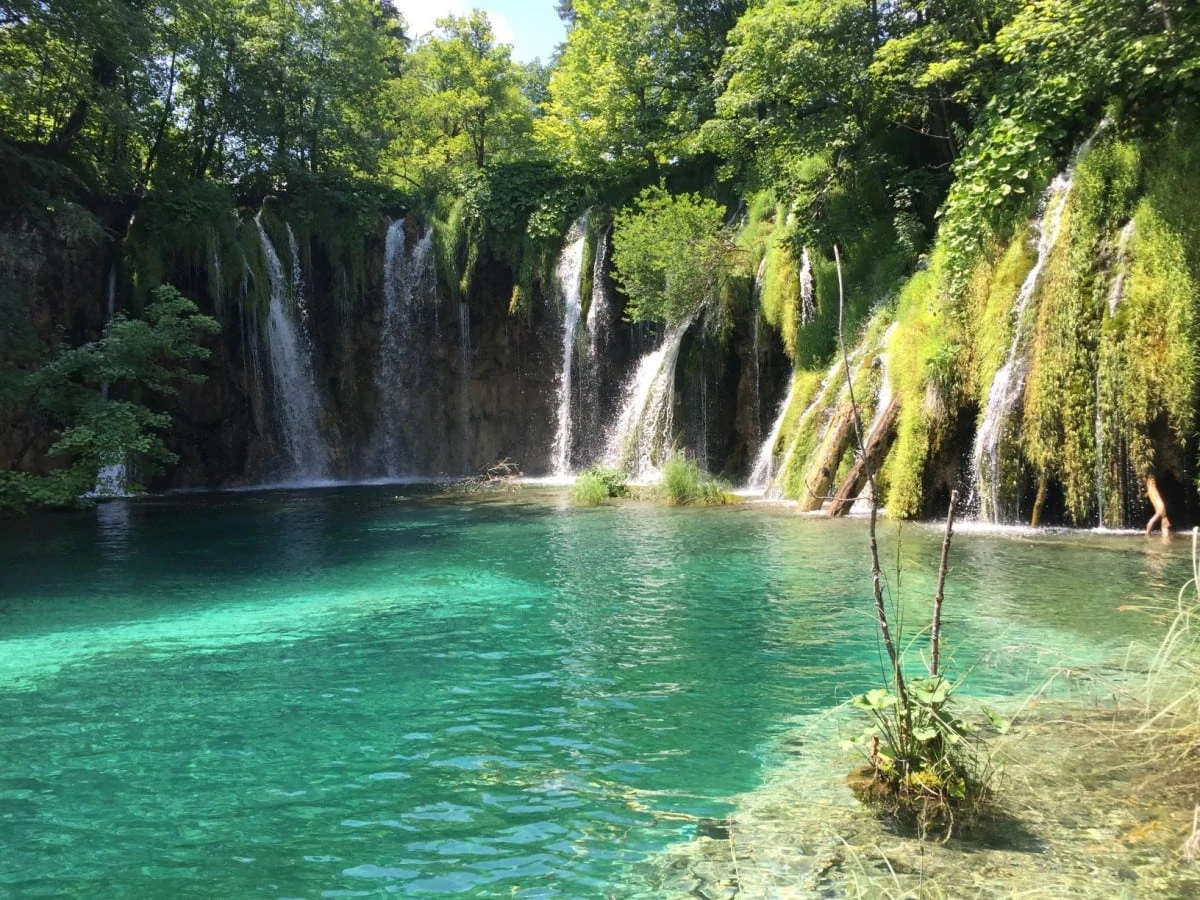
Plitvice Lakes has become one of the most famous landmarks in Europe and no visit to Croatia is complete without witnessing the spectacular beauty of this National Park. It is unlike any other place in the world with a summer visit the best time to see the cascading waterfalls into the emerald blue lakes.
Photos tell a thousand words to describe the prettiness of Plitvice. Custom built timber boardwalks snake their way around and over the lakes to enjoy views from all angles and there are eight trails or loops that can be taken to experience both the upper and lower lakes.
Highlights of Plitvice include the Veliki Slap waterfalls which is the highest one at the lakes. The lower lakes are really beautiful and densely packed with waterfalls and scenic viewpoints. We particularly loved the upper lakes though, later in the day when the tourists had all left and we had entire lakes to ourselves to enjoy in peace.
Interestingly the Lakes only form about 1% of the total area of Plitvice Lakes National Park. There are many beautiful hiking and biking trails meandering away from the lakes to enjoy the mountainous area in full.
It is recommended that you arrive as soon as the gates open to visit at the most peaceful time of the day. This is best achieved by staying in a hotel nearby to the Plitvice Gates. We would recommend at least two days to fully appreciate the whole area, but it can also be done pretty well on a day trip.
Did Plitvice Lakes make it onto our list of the most famous landmarks around the world?
Diocletian’s Palace, Split
Explored by Disha from Disha Discovers
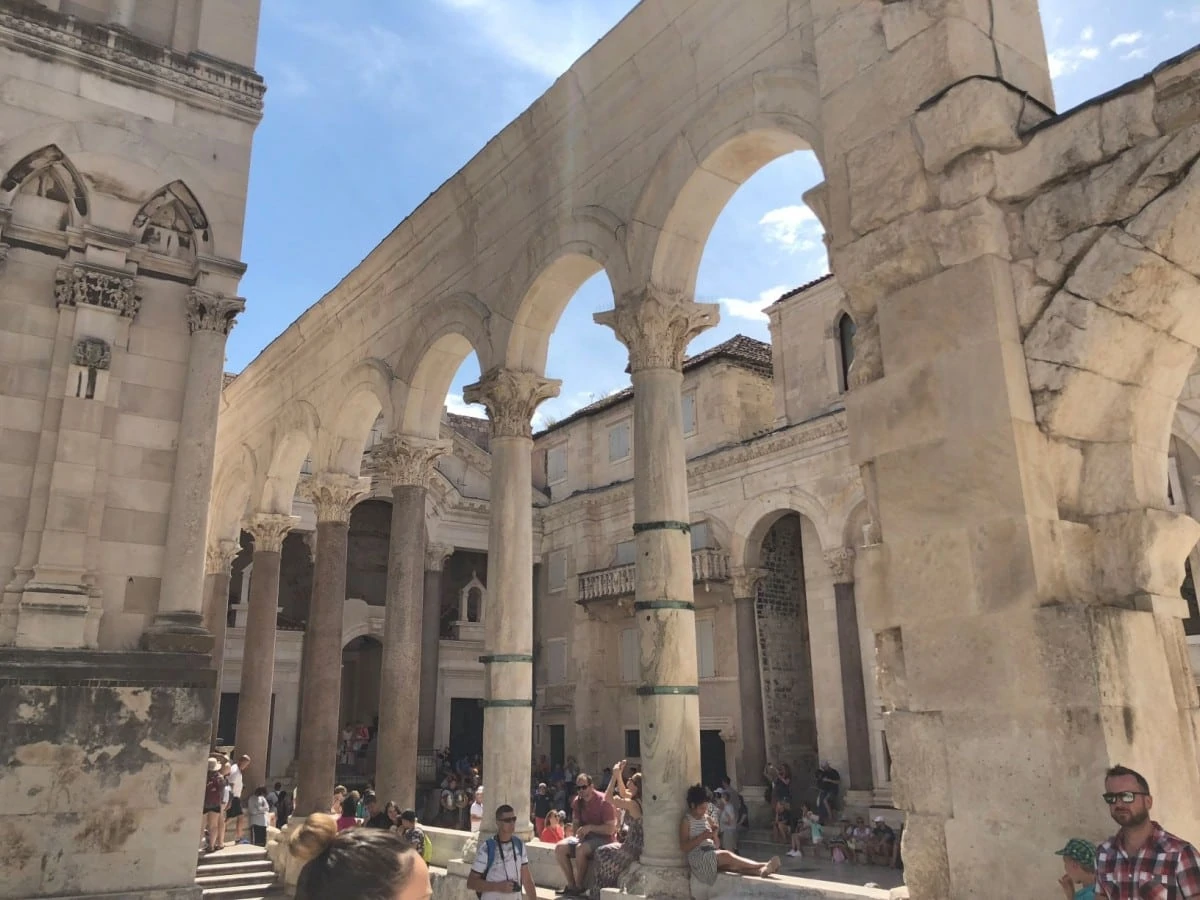
Croatia is a gorgeous country in Southeast Europe that lies on the coast of the Adriatic Sea. Tourists are drawn to it because of the stunning scenery, delicious food, and the relaxed atmosphere. One of the best reasons to visit Croatia is to explore the iconic landmarks and monuments, including quite a few UNESCO World Heritage Sites.
One such prominent landmark is Diocletian’s Palace in Split. It’s the main attraction in Split and was built in the 4th century by a Roman Emperor named Diocletian. He settled in this spectacular palace after he retired. It has the structure of a fortress and was used as a place of residence and for housing military garrison back in the day.
Today, the palace is considered part of Split Old Town and has numerous cafes, restaurants, shops, apartments, and more surrounding it. Visitors can wander around the palace for free. However, there are some excavated remains in the basement and visitors have to pay for a ticket to see them. There are also tour options available with local guides.
Diocletian’s Palace is a great spot for Instagram-worthy shots. The area tends to get busy during the late morning hours, so it’s advised to visit early in the morning.
Recommended: Interested in more Venetian and Roman monuments? Check out our list of the most amazing Italian Landmarks.
Dubrovnik City Walls
Explored by James from The Travel Scribes
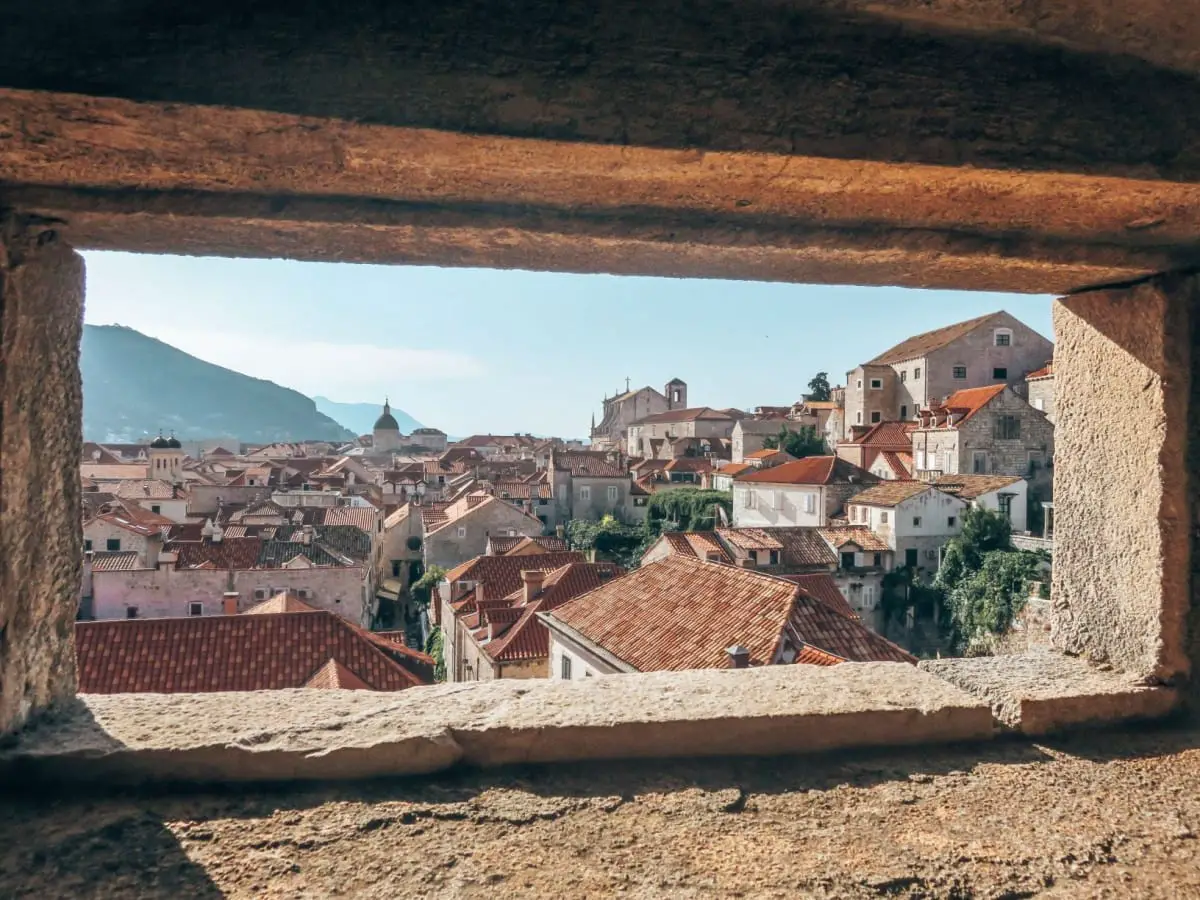
There are so many landmarks in Dubrovnik, from the stunning Dubrovnik Cathedral, the limestone-paved main street, Franciscan Monastery, with its library and ancient pharmacy, and St Ignatius Church – but it’s what surrounds them all that makes it onto the list of best landmarks in Croatia – the Dubrovnik city walls.
A filming location for HBO’s massive hit series, Game of Thrones, the 2km walls that surround Dubrovnik Old Town are also one of the most popular destinations and attractions in the city, filled with rich history. And it’s no surprise, when you’re up there and have stunning views of the red-tiled rooftops, and out to the Adriatic and Lokrum Island.
Although it’s not the cheapest thing to do in the city (costing about 30 USD/24 GBP) a person, we think that it is well worth the money, but make sure you’re up early and some of the first on the walls, so you can have them all to yourself…
Related: Most famous landmarks in Germany.
Krka National Park
Explored by Krisztina from She Wanders Abroad
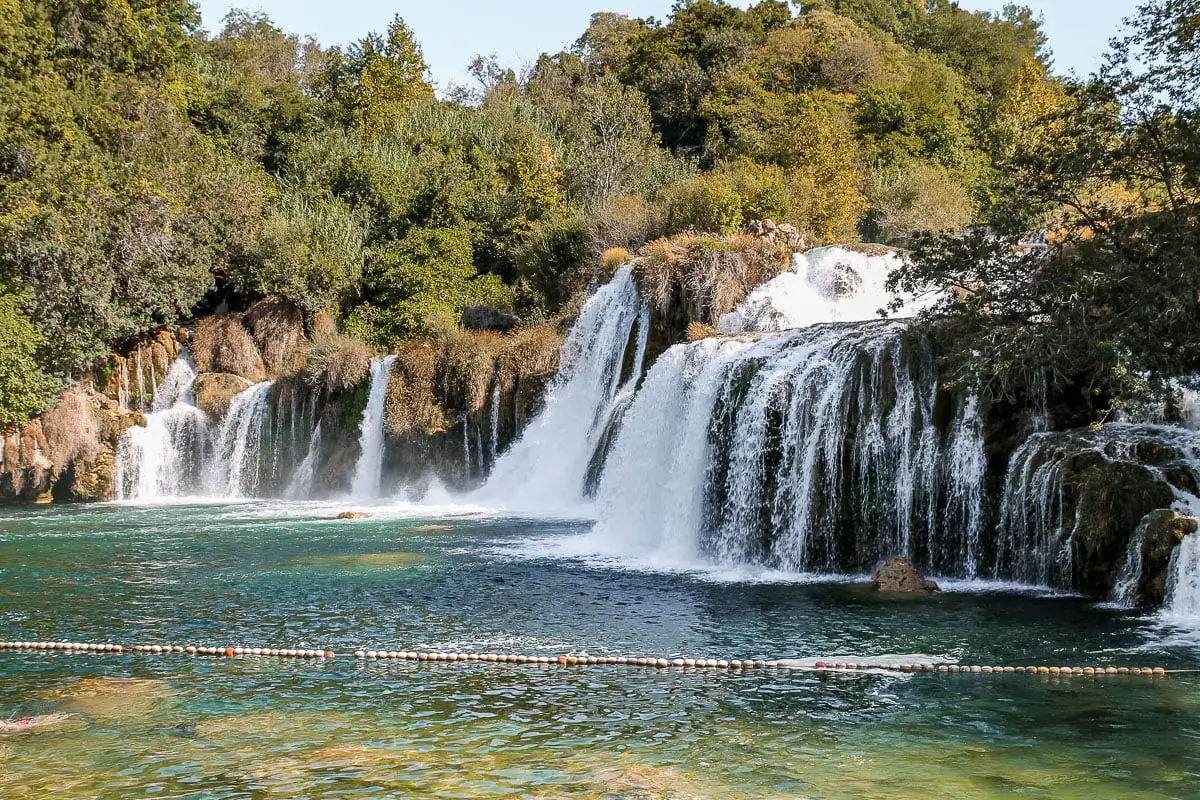
Krka National Park is one of the must-see places in Croatia. The park was named after the Krka River and it covers an area of more than 100 square km, therefore it’s impossible to see everything in only one day. However, if you only have time for a day trip from Split or Sibenik, it’s still worth visiting!
The park has multiple entrances and while some parts can be visited by car, other sites are reachable only by boat excursions. If you have limited time, it’s best to start at the Lozovac entrance from where you can take a walk on the Skradinski Buk trail. It’s a very easy trail so it’s perfect for families as well, and it will lead you to one of the main attractions in the park, the Skradinski Buk waterfall. It’s actually a connection of 17 waterfalls and it’s possible to swim in the waters so don’t forget to bring your swimsuit with you!
After visiting the famous waterfall, it’s worth taking a boat excursion to Visovac island and Roski slap as well. The boats are departing from Skradinski Buk and the excursion lasts for 4 hours which includes a 30-minute stop for sightseeing on Visovac island.
Krka National Park can be visited all year round, there are different types of tickets based on which season you’re visiting and which sites you’re planning to see. For example, if you want to see all accessible land sites in the summer months, it will cost 200 HRK (24 GBP / 32 USD) per person.
Pula Arena
Explored by Emily from Wander-Lush
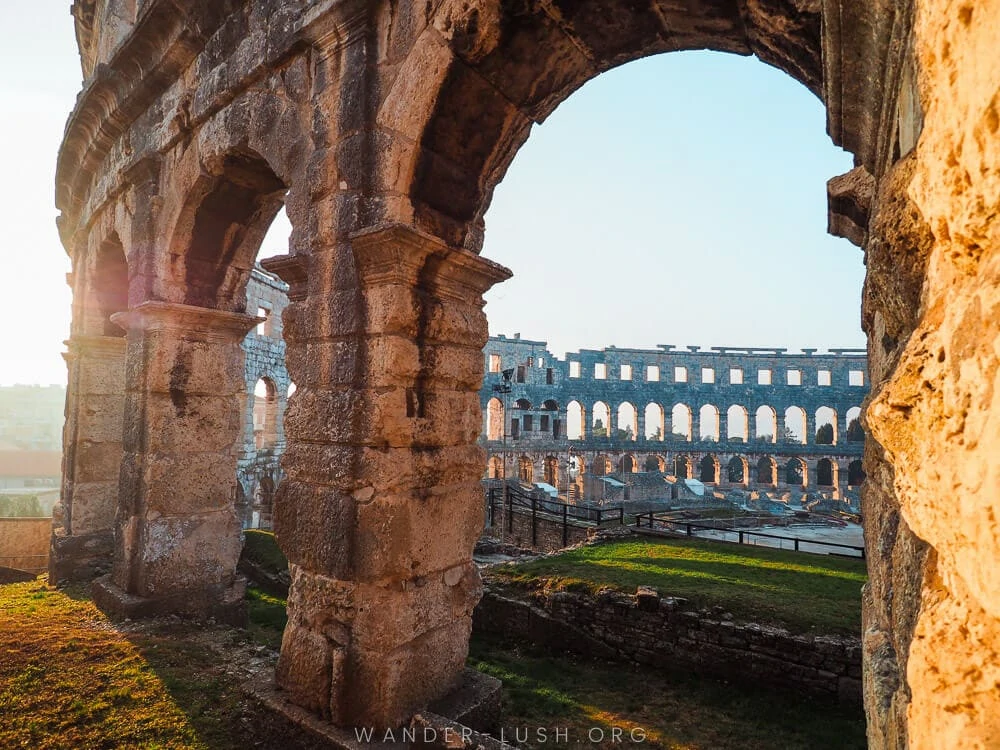
One of the world’s six largest surviving Roman amphitheatres, Pula Arena is an icon of Croatian Istria and one of the country’s must-visit landmarks.
The arena stands on a low hill in the northern part of Pula, a city close to the tip of the Istrian Peninsula. Constructed in 27 BC, the structure has immense historic value because it’s the only Roman amphitheatre still standing today with all four side towers in-tact.
Seventy-two perfect arches built from limestone reach more than 100 feet into the air. In its heyday, the arena could accommodate 23,000 spectators who gathered here to watch gladiatorial games. In the 1500s, the ruling Venetian Senate petitioned to dismantle the arena and relocate it to Venice, such was its beauty and grandeur. Locals protested and the arena remained on Croatian soil.
Today, Pula Arena is used for music and theatre events, and hosts an annual film festival. There is a small museum inside the complex that displays archaeological finds from the area. If you don’t want to pay the ticket price, it’s equally rewarding to simply wander around the exterior. Sunset is the nicest time to visit.
When in Pula, be sure to also visit the second, smaller arena, the Gate of Hercules, Arch of the Sergii, the Temple of Augustus, and the other monuments that speak to Istria’s Roman history. The best aerial views of the arena can be found at Fortress Kaštel in the centre of the city.
Spanish Fortress, Hvar
Explored by Mim and Mark from The Common Wanderer
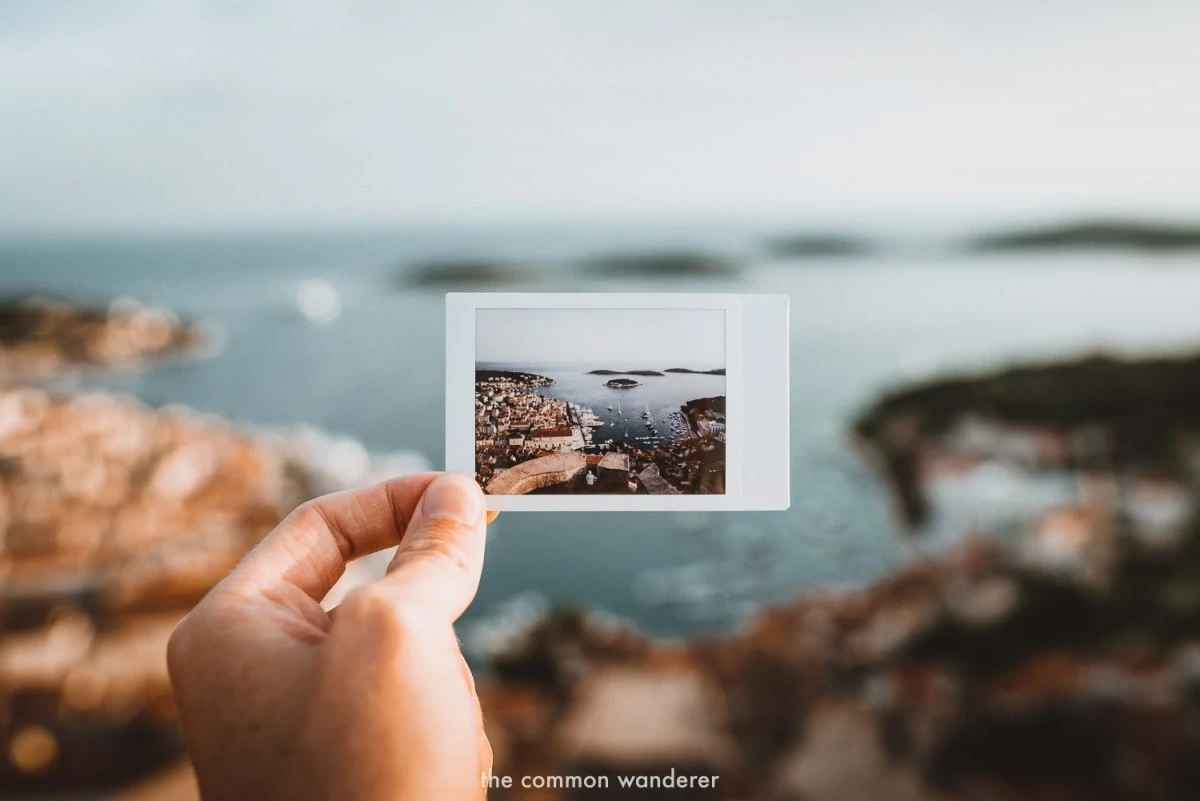
Overlooking the terracotta roofs and white-washed walls of Hvar’s alluring old town, with the glistening turquoise waters of the Pakleni Islands in the distance, lies the Spanish Fortress (Tvrdava Fortica), home to one of the best Hvar viewpoints.
Originally the site of a 6th century Byzantine citadel, the Venetians eventually constructed the present-day fortress in the 13th century.
In 1571, the Fortress acted as shelter for locals after an invading Turkish army attacked and razed the town to the ground. It’s also been known as the Spanish Fort (Trvdava Spanjola) as Spanish engineers worked on it during the 14th century.
Fortunately, the Fortress is now on far safer ground, and houses a small museum showing a collection of historical artefacts found on the seabed around Hvar. However, most come for the imperious views from the fort’s imposing walls, best visited during Hvar’s famous golden hour sunsets.
The Fortica is easy to get to – just follow the signs from St Stephen’s Square, up the (many) stairs, before passing the town walls. From here, it’s a gentle, winding walk through the pine forests before arriving at the fortress entrance.
The entrance fee is pretty expensive (40 HRK / 4.75 GBP / 6.50 USD) especially for those on a backpacker’s budget, but it’s undeniably worth it.
Klis Fortress, Split
Explored by Flo from Yoga, Wine & Travel
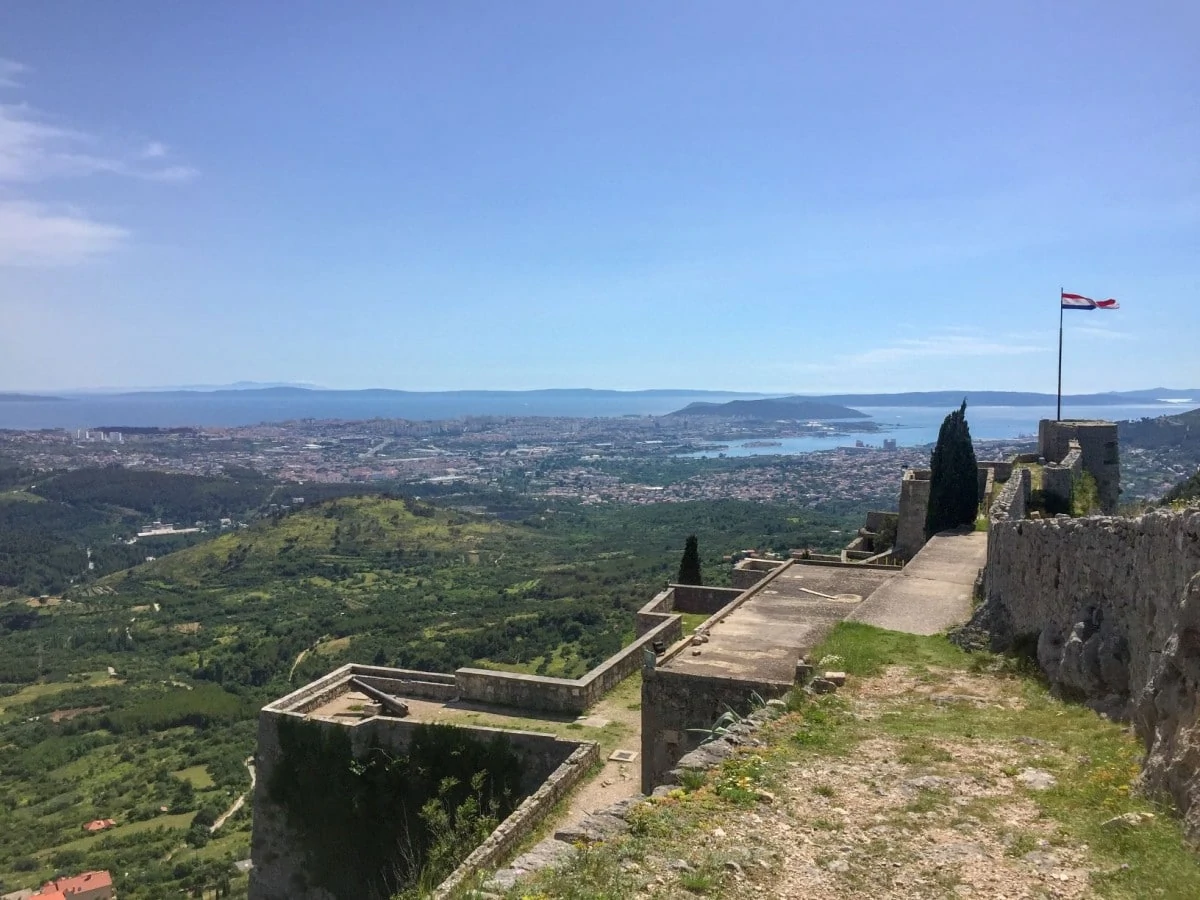
If you are a fan of Game of Thrones, then this behemoth structure might look familiar: it was used as the filming location for the city of Meereen in Slaver’s Bay.
The fortress overlooks the Croatian city of Split and is thought to date back to the 3rd century BC. Because of its strategic position atop a steep towering mountain with panoramic views of the surrounding area, Klis Fortress played a critical role in the military defence of Croatia. The majority of the areas within Klis Fortress are open to the public, and you can easily spend an hour or so exploring the grounds on foot and wandering through a fortification that was once held by the Dalmatians, the Roman and Ottoman empires, the Venetian army and French rule. Make sure you head towards the Oprah Tower which once served as the most important defence stronghold of the western portion of the fortress.
As Klis is only approximately 15 kilometres from the heart of Split it is a fantastic day trip option for those looking to escape from the crowds, and the fortress also tends to be much quieter with fewer visitors. The fortress is typically open every day and adult tickets cost 60 HRK (7.15 GBP / 9.50 USD); Klis can be reached by bus in 15 to 20 minutes from the old town, or alternatively you can drive and park here relatively easily.
Korčula Old Town
Explored by Karen from Big Adventures For Little Feet
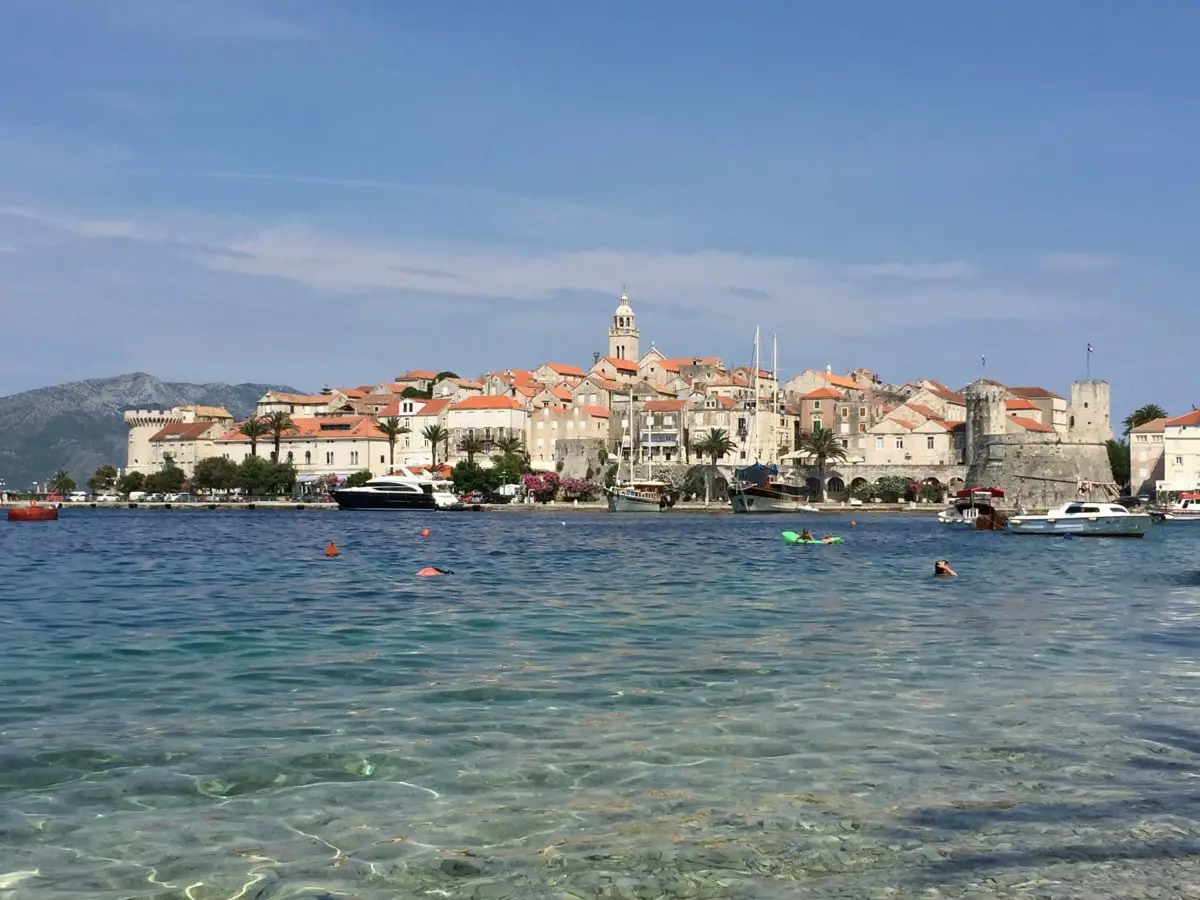
For a Croatian Island with a difference you must visit Korcula, in particular its pretty old town. Dubbed ‘little Dubrovnik’, Korcula Old Town is a well-preserved medieval walled city providing all the character of a visit to Dubrovnik but without the crowds.
Interestingly the old town was designed in a fish shape with lots of narrow laneways peeling off from the main street or the fishbone to protect the homes from winds.
Korcula’s architecture is largely Venetian Renaissance-inspired and the grey buildings are beautifully backdropped by the turquoise Croatian waters. Spring and summer are ideal times to visit when flower boxes overflow from balconies and bring the laneways to life for a pretty place to stroll and explore for a few hours.
The most significant building is the 15th century St Mark’s Cathedral located in the centre of Korcula Old Town. For a small fee you can climb the cathedral tower giving lovely views over the town.
Another noteworthy landmark in Korcula Old Town is the childhood home of Marco Polo.
Setalista Petra Kanavelica is the street to be in the evenings for great food and sunset drinks. Located on the outer eastern wall restaurants are perched overlooking the ocean and provide the perfect ambient end to a visit to Korcula.
Zlatni Rat, Brac
Explored by Vaibhav from The Wandering Vegetable
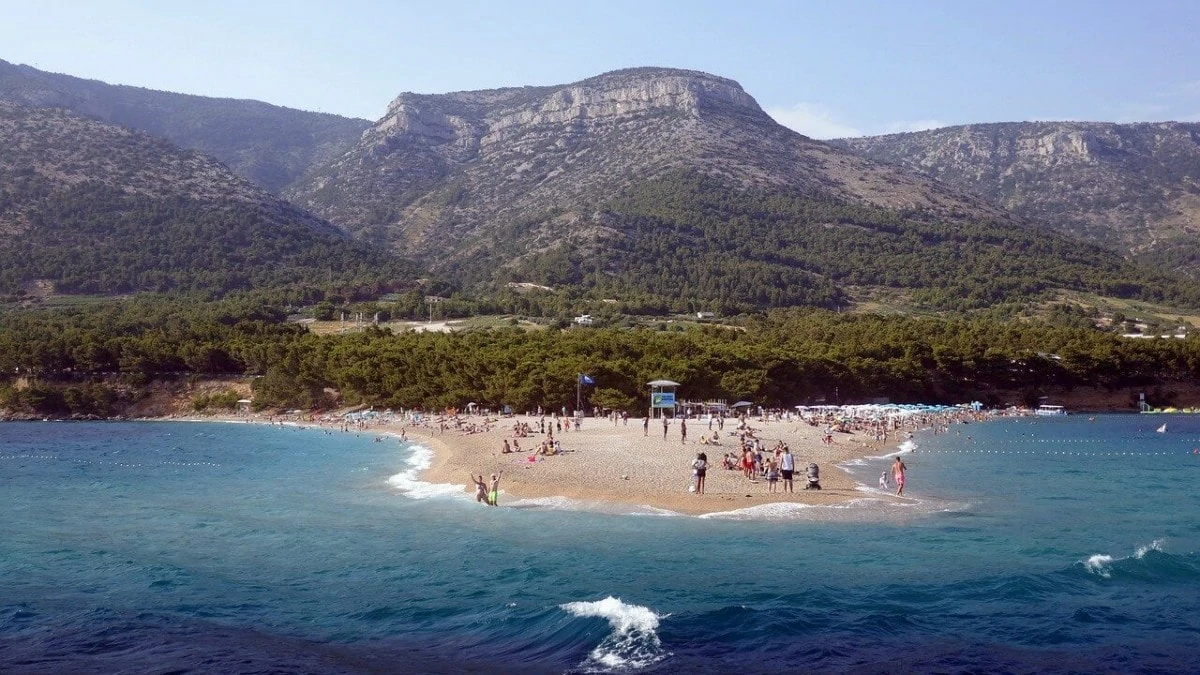
Located on the southern end of the paradisiacal island of Brač, about 2 km away from the town of Bol, is the most iconic spot in Croatia called the Zlatni Rat Beach. It is not only the most beautiful beach in Croatia but is regularly listed in travel rankings as one of the top beaches in Europe as well.
It is a white pebble beach, so you don’t have to worry about sand in your shoes! What makes this beach so unique is its dynamic nature where it changes shape every few days. No kidding, the land of the beach keeps changing its shape depending upon the wind and water current…
The beach looks like a small tongue dipping into the Mediterranean Sea. Water at the beach is a lovely shade of turquoise blue and crystal clear. It is generally warm throughout the year and ideal for swimming. The place is a paradise for surfers and kite surfers.
And the best part about the beach? There’s a lovely promenade full of coffee places, bars and restaurants that lead you to the beach. So you can enjoy a bite, grab a drink and soak in the sun til you please. If you want to avoid the crowds, then try visiting the beach during the early hours of morning.
You can rent beach beds or an umbrella at a nominal price. Entry to the beach, however, is free for all. And if you’re a fan of exploring a town on foot, then a 20-minute walk from Bol gets you to this iconic “Golden Horn” beach.
Bay of Abandoned Hotels, Kupari
Explored by Kami from Kami and the Rest of the World
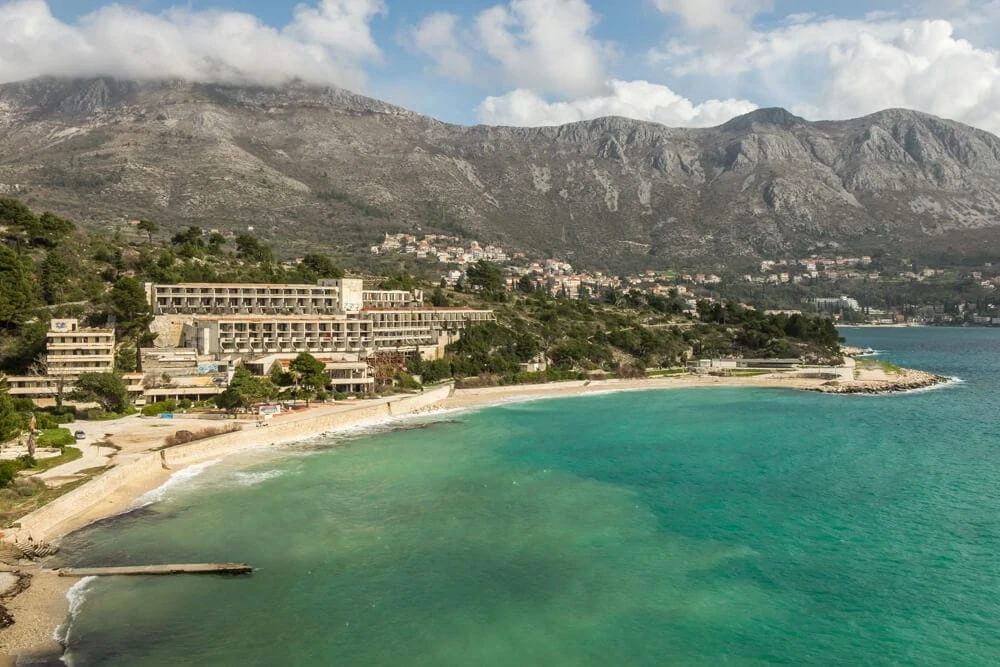
Only a short ride away from Dubrovnik you will find Kupari – the so-called Bay of Abandoned Hotels.
In the past, it used to be the luxurious resort dedicated to the most prominent officials in the former Yugoslavia. Today it is the paradise for the fans of urban exploration since the complex was abandoned at the beginning of the 2000s.
The first hotel, Grand, was built in 1920 by entrepreneurs from Czechoslovakia. In total there were seven hotels in the resort, all of them are abandoned and in the state of decay now. You can easily visit the Bay of Abandoned Hotels and see the hotels inside and imagine how amazing the complex used to be.
If you are brave enough you can even go to the upper floors or the rooftop of one of the hotels to see the stunning panorama of the surroundings. Keep in mind that you are entering the hotels at your own risk and just follow your intuition, if you don’t feel confident just stay in the lower floors or visit only Hotel Grand (which was the most impressive anyway).
You can reach Kupari by public transport (bus no 10 from Dubrovnik towards Cavtat) or by car – you can park in front of the hotels.
Fort Lovrijenac, Dubrovnik
Explored by Dean & Laynni from Routinely Nomadic
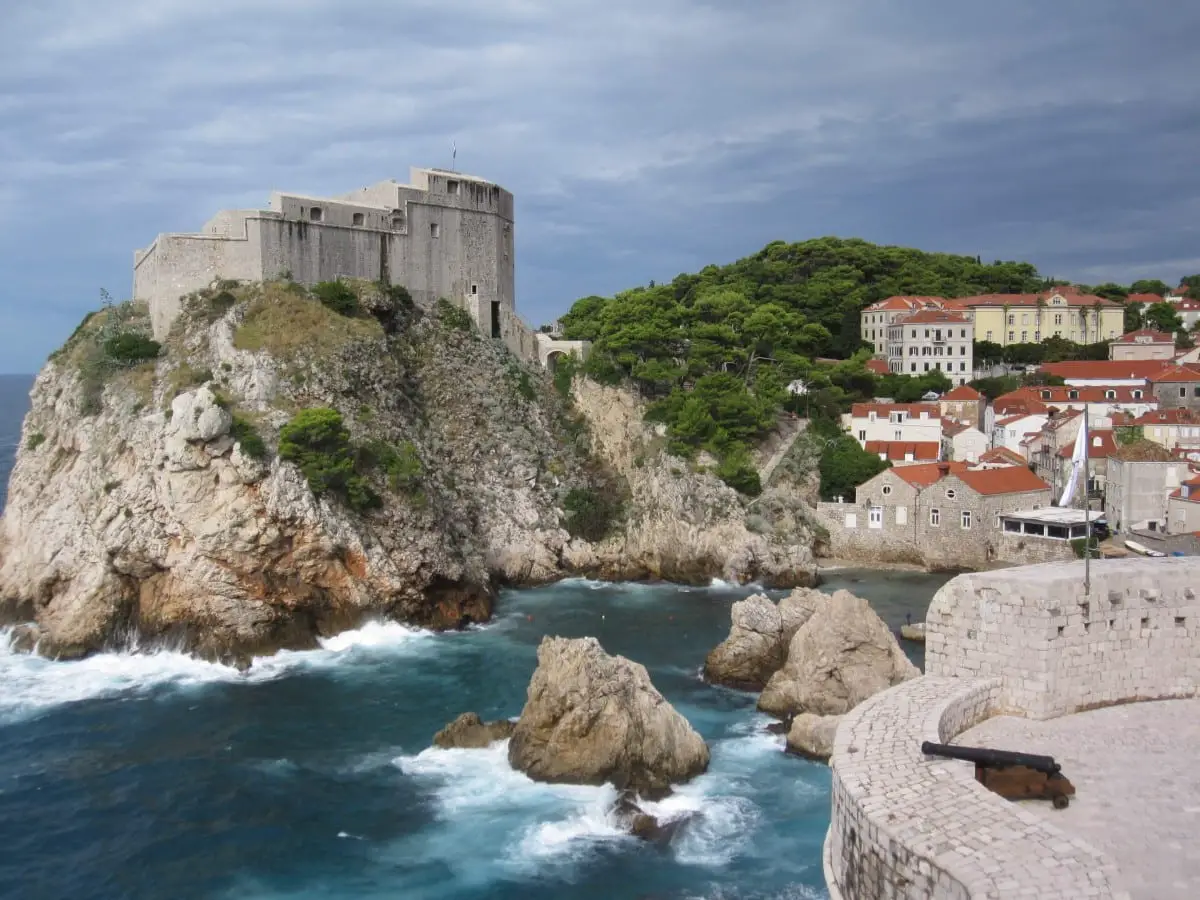
While the fabulous walls of Dubrovnik are known far and wide, not least of all for their starring role in Game of Thrones, nearby Fort Lovrijenac definitely rivals them for spectacular setting and scenic appeal. In addition, this thousand-year-old masterpiece looming 37-metres high just happens to be the best place in Dubrovnik to capture classic photos of the famous walls. Unfortunately, the gates to this iconic fortress close just before sunset (why, exactly, we’re not sure) but it is still worth visiting as late as possible to enjoy the stunning views in the soft light and picturesque colour unique to evenings on the Adriatic Sea.
Also known as St. Lawrence Fortress, it houses the St. Lawrence chapel and is regularly used as the venue for live plays and entertainment. Along with the justifiably popular expansive views out over both sea and city, the multiple levels inside feature a fascinating mix of dank, dim inner fortress, utilitarian defences, and antique cannons (terrific for both photos and occasional riding). It is also hard to top a varied history that includes both rebuffing naval attacks by medieval Venetians and hosting an annual Red Bull cliff diving competition. Whichever you find more exciting, magnificent Fort Lovrijenac should not be missed.
Tickets to the fortress can be purchased for 50 HRK (6 GBP / 8 USD) or included with your 200 HRK (24 GBP / 31 USD) Dubrovnik walls admission.
St. Mark’s Church, Zagreb
Explored by Sarah & Kris from Jet Setting Fools
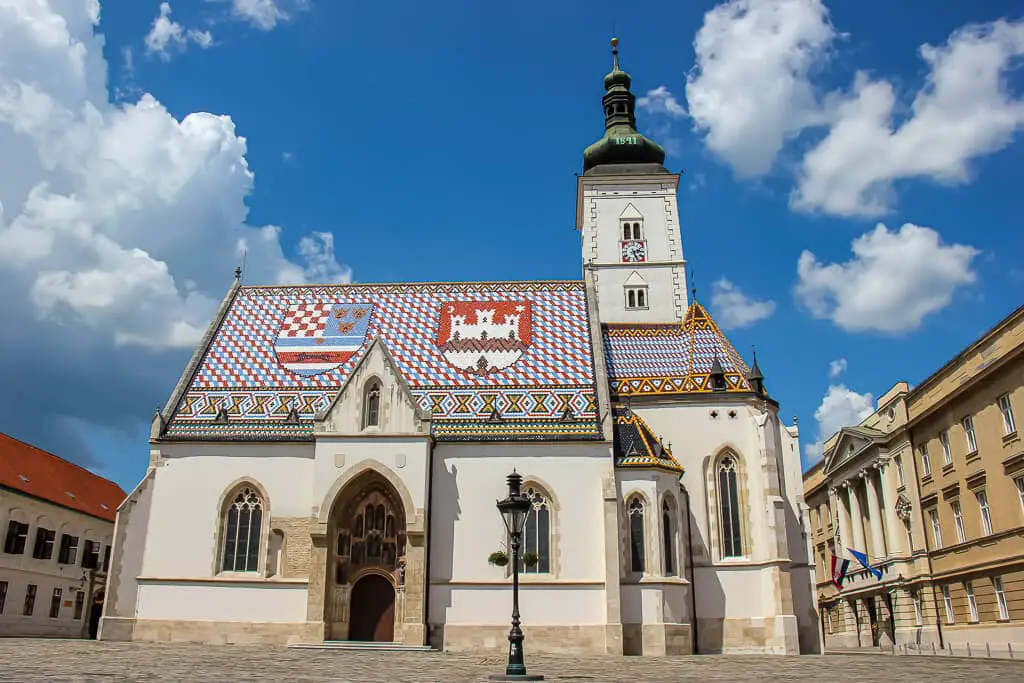
St. Mark’s Square is the political heart of Zagreb – Croatia’s vibrant capital city. The square, located in the upper district of Gornji Grad, is flanked by stately government buildings, with the eye-catching St. Mark’s Church standing like an island in the center of it. Dating back to the 13th century, the church ranks as one of the oldest remaining structures in the city. Due to fires and earthquakes, the church been expanded and renovated throughout its history.
The most striking restoration occurred in 1880, when the church’s colourful rooftop was installed. Differing from the traditional orange rooftops seen throughout the old city, the vivid church tiles are designed to depict the Coats of Arms of the city (on the right) and the country, which at the time was the Kingdom of Croatia, Slavonia and Dalmatia (on the left).
Another striking feature of the church is the elaborate south-facing portal. While not clearly visible from afar, there are 15 carved Gothic statues tucked into the arch above the door that are well-worth an up-close look.
Although the church’s exquisite exterior is what attracts many visitors to St. Mark’s Square, there are other sights of interest on the opulent square. Dominating the east side of the square is the columned Croatian Parliament Building, while the Ban’s Court occupies up the entire western side.
Note: While the church is still a functioning place of worship that is open for mass, the interior is rarely accessible to visitors.
St James Cathedral, Sibenik
Explored by Veronika from Travel Geekery
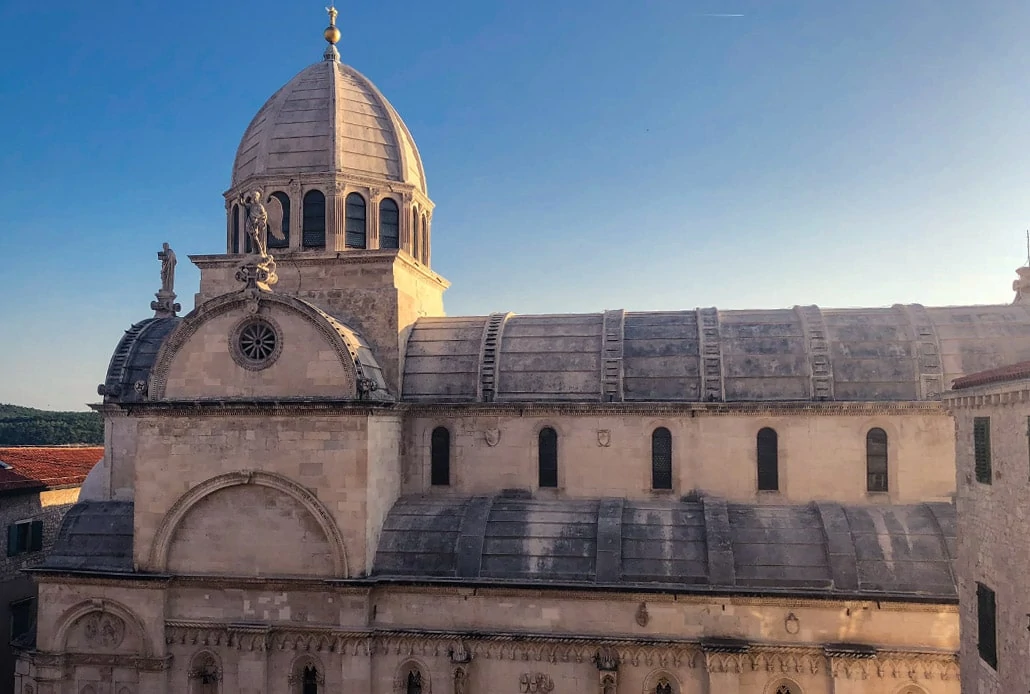
St. James Cathedral is undoubtedly the no. 1 landmark in Sibenik, Croatia, even though it’s not the only UNESCO monument in the city.
The large church was built in the 15th century in Renaissance style by George the Dalmatian, a local Croat who acquired his unique building skills in Venice. Throughout the years many Gothic features were added.
The Cathedral was built using a method of interlocking stone slabs. Even its large dome was built like that, with no connecting material used whatsoever. That changed during a reconstruction in the 90’s after Sibenik was bombarded during the Yugoslav wars. Contemporary builders were not able to recreate the interlocking slabs on the dome, so some cement had to be used.
While on the outside, the church is creamy white, the interior is in stark contrast – it’s dark and feels even grander than it is. Humidity has turned the walls black, but extensive cleaning is ongoing, so that might change soon.
There are many notable features of the Cathedral, which you cannot find elsewhere. Such as the baptistery is uniquely located inside the church, even though when it was constructed, it was typical to have them out back. And the ornate room doesn’t have any photos of baby Jesus, since every baby is a child of God.
74 heads decorate the outer structure in a neat row and none of them looks down at you, neither do they look at each other. Local inhabitants of the time posed as models for these!
Varazdin Castle
Explored by Nisha & Vasu from Lemonicks
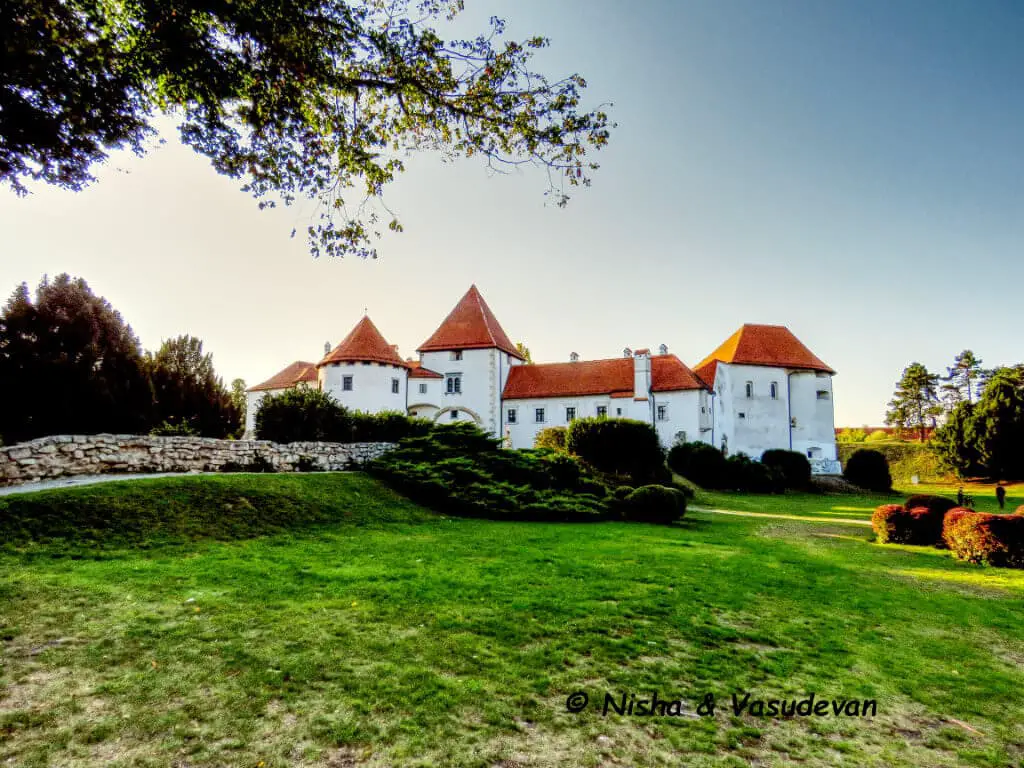
Visiting the old town Castle is one of the most memorable things to do in Varazdin. It is an important monument in Varazdin. The construction of this castle started in the 14th century and it was built and rebuilt multiple times for over four centuries in different architectural styles owing to different owners and their preferences. When the Turks invaded it in the 16th century, high walls were added to the structure. At this time, the castle became an example of a modern defensive system, which can be seen even today in its walls.
Today the castle houses the Varaždin City Museum, with permanent exhibitions of historic documents, signet rings, sceptres among other amazing artefacts. There are also collections of art and firearms such as a guild collection, cannons, and firearms as well as glass, clocks and ceramics. The attractive rooms have been styled in several different styles and chronologically displayed starting from Renaissance, Baroque, Rococo, Empire, Biedermeier, Historicism and Art deco. There’s a chapel dedicated to St. Lawrence inside the castle.
Ston City Walls
Explored by Sharon from Daily Dream 360
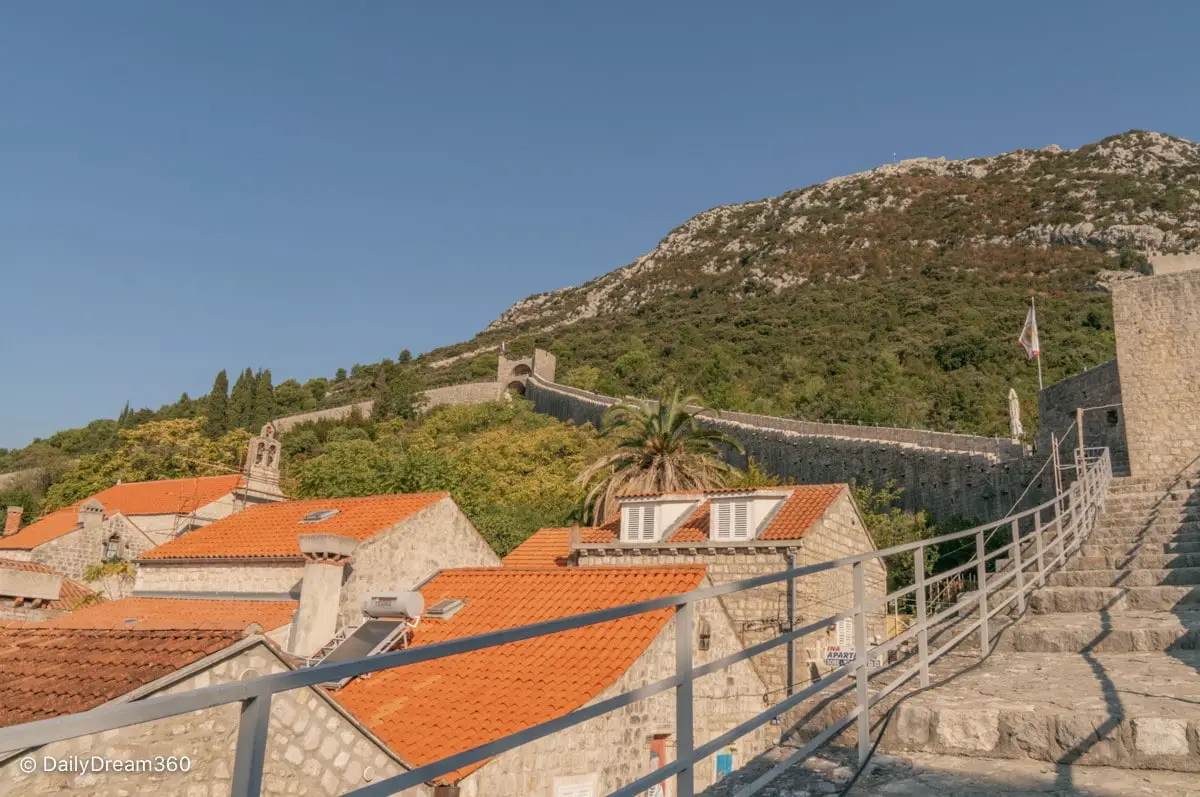
During a 7-day Adriatic cruise in Croatia, we had to option to take a day trip to the Pelješac Peninsula and the picturesque town of Ston. While the cruise ship made its way to Dubrovnik, we took a scenic bus ride in the peninsula, discovering its two primary industries, salt and wine.
Our first stop was in the town of Ston and its famous City Walls. The wall is often referred to as the “Great Wall of Croatia” and is the world’s longest preserved city wall. Originally 7 km long, the wall was built in the 14th and 15 centuries, and visitors can walk the wall year-round. There is a small fee to enter and some steep stairs to climb, but the top views are spectacular.
While in Ston, you can walk the narrow streets and browse through the many small shops. Grab a coffee at one of the many sidewalk cafes. Be sure to visit one of the many wineries in the area to partake in a local wine and cheese tasting.
Located approximately one hour from Dubrovnik, Ston visits make an excellent excursion for the cruise trips between Split and Dubrovnik. You can also take a day trip from Dubrovnik, which will consist of the scenic drive, wine tastings, wall walk and time to explore the town.
Salona Roman Ruins
Explored by Wendy from The Nomadic Vegan
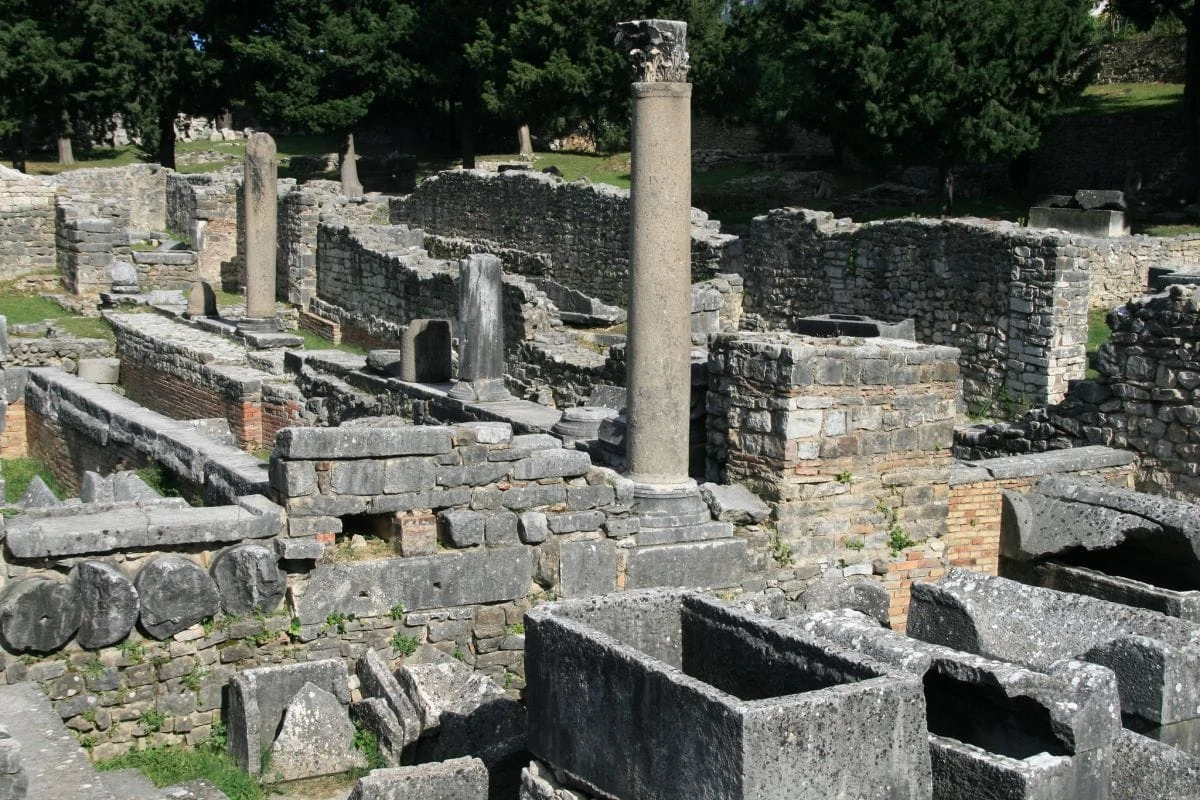
Nowadays, you’ll often hear people say that the ruins of Salona (or “Solin” in Croatian) lie just outside of Split. But originally, it was the other way around. Now a sleepy town of fewer than 25,000 inhabitants, Salona was a much larger ancient Roman town of about 60,000 inhabitants and the capital of the Roman province of Dalmatia. Roman emperor Diocletian built his private palace in the countryside outside Salona after he became the first sitting emperor to voluntarily stand down. He spent the rest of his days living in his enormous palace and planting cabbages.
Several centuries after Diocletian’s death, the residents of Salona decided to abandon their town and move into the palace. That was how the city of Split began, and the ruins of Diocletian’s palace still make up the core of the city centre today. As for Salona, it’s the largest archaeological park in Croatia, and inside you’ll find well-preserved ruins of temples, a theatre, an amphitheatre, a basilica and a number of other ancient buildings.
You can get there from Split on city bus No. 1, which leaves from Trg Gaje Bulata every half hour and goes all the way to the Salona parking lot. There’s plenty to see, so allow at least half a day to fully experience Salona. While there are some restaurants in the modern town of Solin, dining options at the ruins are very limited, so you may want to pack a lunch. This is especially true for vegetarians or vegans in Croatia or others with specific dietary needs.
Odysseus Cave, Mljet
Explored by Oksana & Max from Drink Tea & Travel
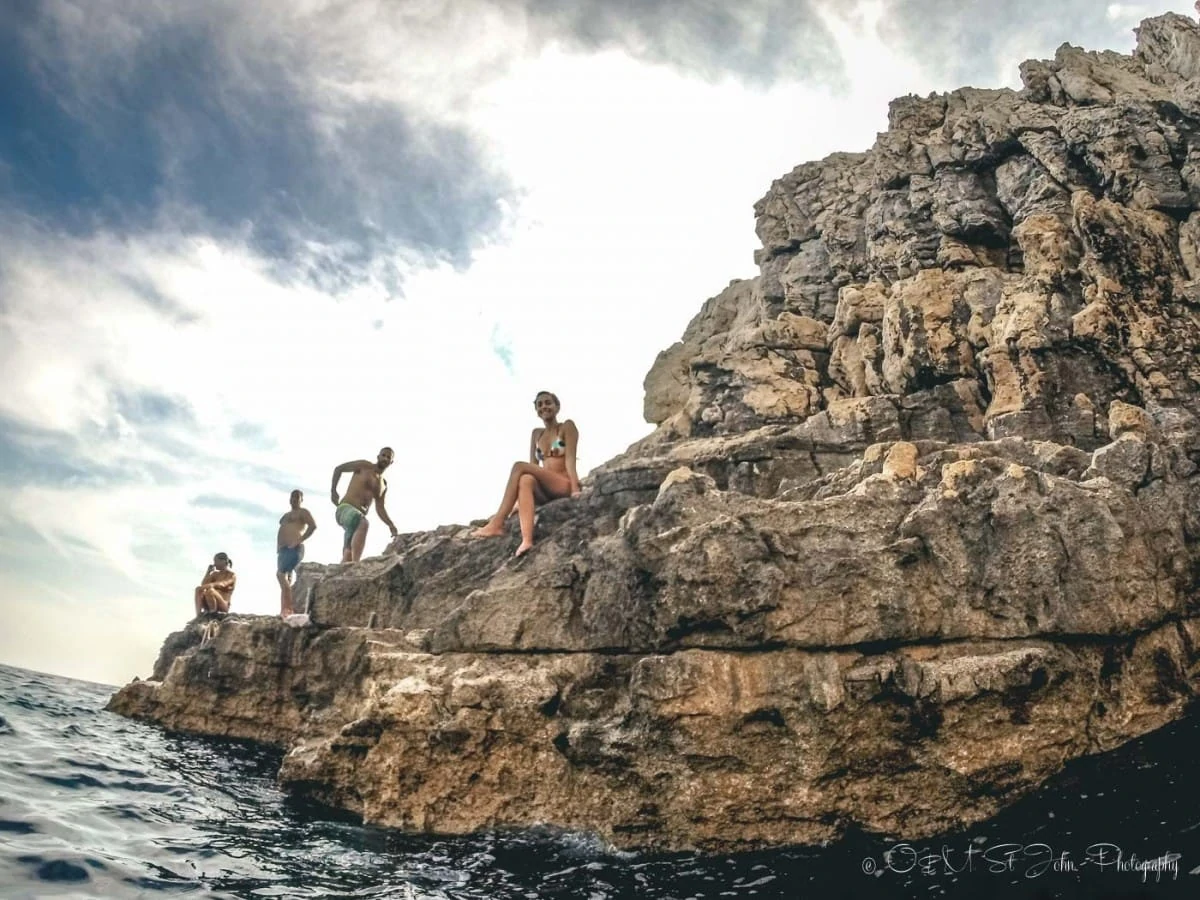
Odysseus Cave in Mljet is one of Croatia’s lesser known landmarks, but it is stunning, nonetheless. Located on the Southern Coast, it is tied to many local legends and it is an excellent place to spend the day swimming, snorkelling or cliff jumping.
Just in front of Odysseus Cave is a giant rock which is covered by the sea in high tide. Local legend says that Odysseus was shipwrecked on it and swam to the cave for safety. There he was bewitched by a nymph which kept him there for 7 years.
Today, fishermen sometimes use the cave to safely store their boats against the elements. However, it is not hard to see why the cave would be tied to local legend. The juxtaposition of light and dark against the turquoise waters is really beautiful.
The easiest way to reach the cave is by boat but you can also embark on a hike down to the cave. We discovered Odysseus Cave while sailing through Croatia, and it quickly became one of the highlights of our trip.
The majority of people that visit Mljet, or Odysseus Cave, do so on a day trip from Dubrovnik or on a brief stopover while island hopping. However, you could spend many days exploring all the island’s nooks and crannies.
Sea Organ, Zadar
Explored by Megan from Virginia Travel Tips

One of the most famous sights in Zadar is the Sea Organ. It is situated down at the main promenade in Zadar and is a must-visit if you find yourself in the Croatian city that is known for being its sunset capital.
The Zadar Sea Organ was open to the public in April 2005 and has lit up the old town ever since. The history of the Sea Organ is rather fascinating as it was built in an attempt to give a facelift to the seafront in Zadar from WWII. The construction after WWII was built in a brutal manner just leaving a long wall of concrete with very little personality or life. Nikola Basic was given the job of redesigning the Nova Riva (city coast) and the Sea Organ was his brainchild.
When the waves break on the wall, it creates beautiful and harmonic effects and sounds. Locals and tourists both flock down to sit along the water and listen to the relaxing sounds. In the evenings, the sight is lit up with colourful lights and draws in a lot of people.
In 2006, the Zadar Sea Organ won the fourth edition of the European Prize for Urban Public Space. One of the best things to do in Zadar is to head down to the promenade, sit on the marble stairs, and watch the sunset as you listen to the sea organ playing music.
St. Euphemia Church, Rovinj
Explored by Lori from Travlin Mad
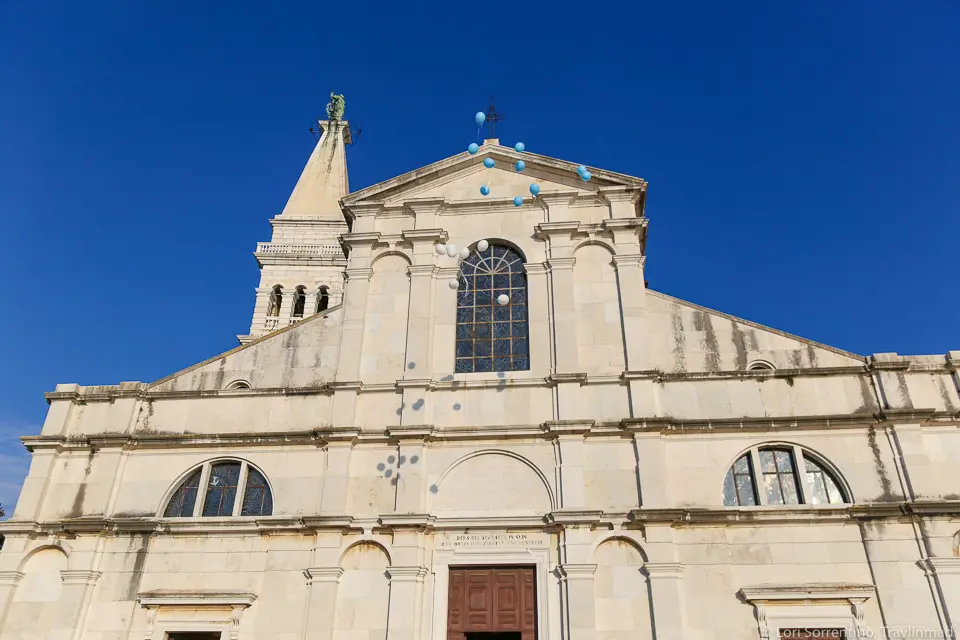
The seaside city of Rovinj on the Istrian peninsula of Croatia feels Venetian, not surprising given its long rule of over 500 years by the Doge of Venice. It’s a charming city and popular tourist destination for travellers to Croatia, and also day trippers from Venice who take the ferry across the sea.
One of the most popular things to do in Rovinj is to visit the Church of St. Euphemia, perched high on the hilltop overlooking the town. The Baroque steeple and campanile bell tower was modelled after that of San Marco in Venice. It’s the landmark of Rovinj and can be seen in every photo and likeness of the city.
Built in 1723 and named for the Patron Saint of Rovinj, the church is the centre of life here. Inside you’ll see stunning frescoes and the three naves built upon the ruins of older Christian structures. Visit on the weekend and you’re likely to see, and be invited to, a local wedding, baptism, or other celebration. It’s an easy walk uphill from the Rovinj marina or the port of Valdibora, and the church is still surrounded by remnants of the original 12th century city wall.
Be sure and climb the tower for the best view of Rovinj!
Top tip: If you love churches and want to continue your Croatian adventure up the coast from Rovinj, definitely check out the gorgeous seaside town of Porec with it’s famous sixth century Euphrasian Basilica.
Blue Grotto, Biševo
Explored by Lee from The Travel Scribes
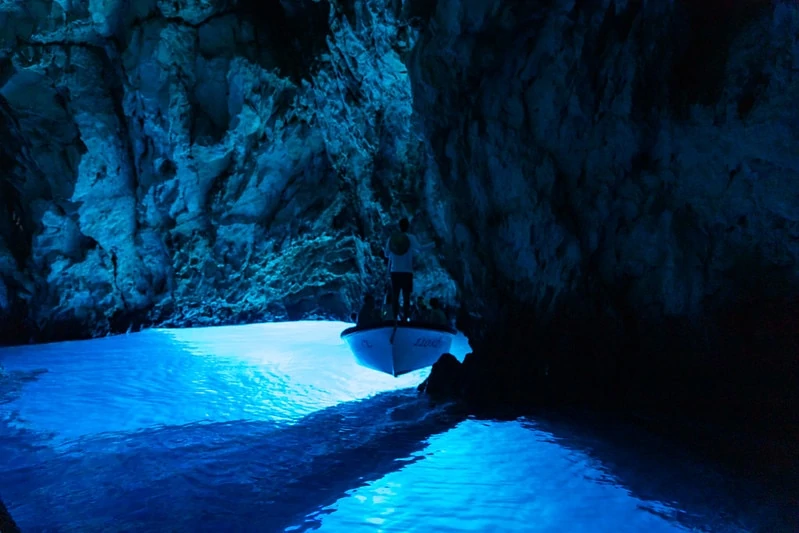
Photo credit: Dronepicr / Flickr
Probably nobody would ever have heard of the island of Bisevo without the huge fame of its most famous ‘resident’, the Blue Grotto or, as it’s more well known, the Blue Cave. Situated about 5 kilometres away from the stunning island of Vis, essentially it’s a sea cave waterlogged with water which, between the hours of 11 am and 1 pm on a sunny day, is bathed in bright light which reflects as an electric shade of blue.
The effect is incredible – the entire cave is bathed in bright swathes of blue as it almost shimmers.
It used to be that the cave was only accessible to divers but, in 1884, locals decided to blast a hole in the rock, so that small boats could enter. That, unfortunately, created a tourist trade which sees the almost eerie iconic landmark consumed by visitors, so much so that in July and August the huge crowds mean you might not be able to enter, or are left waiting at the mouth of the cave in your boat.
Read next: Want to see what monuments made it onto the list of best landmarks in France?
So, what do you think of our list of amazing Croatia landmarks? Are there any must-visit destinations or tourist attractions in Croatia that should have made it onto the list? Let us know in the comments below!
Want to save this for later? Why not pin it…
